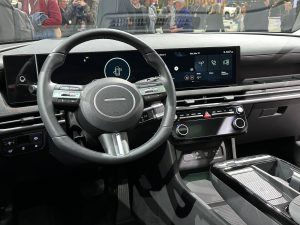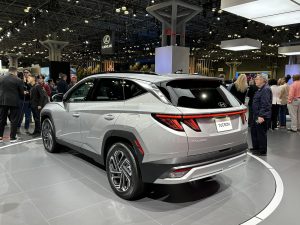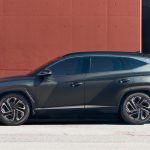South Korean automaker gives its Tucson sport-utility a major overhaul for 2025 model year. Immediately noticeable is redesigned front fascia, but the bigger change comes inside the cabin, which completely different than its predecessor.

Olabisi Boyle, Hyundai’s product planning chief, talks about the finer points of the 2025 Hyundai Tucson at the 2024 NYIAS.
Hyundai’s not afraid to take chances these days so it elected to give its bestselling vehicle, the Tucson, a pretty substantial makeover for the 2025 model year and show it off at this year’s New York International Auto Show.
In addition to a redesign of the front fascia and interior, the new version gets an updated rear, new lighting and new alloy wheels. The 2025 Tucson comes in five variants: 2.5L ICE, hybrid, hybrid N Line, plug-in hybrid and XRT. Within those trim packages are a slew of new or updated safety and convenience technologies.
“The refreshed 2025 Tucson SUV expands the appeal of our full-spectrum eco-powertrain approach, offering internal combustion, hybrid, and plug-in hybrid models in a popular compact SUV design,” said José Muñoz, president and global COO, Hyundai Motor Co., and president and CEO of Hyundai Motor North America.
“With all-wheel drive offered on gas and hybrid models, customers can enjoy all-road, all-weather capability coupled with outstanding efficiency and an attractive variety of trims, including outdoor-focused XRT and sporty N Line models.”
New year, new look
Hyundai’s designers continue with their bold exteriors when it comes to the Tucson. The new ute features Parametric Dynamics design language. The look features kinetic, jewel-like surface detailing, the company believes gives the new Tucson a standout look.

The look features kinetic, jewel-like surface detailing, the company believes gives the new Tucson a standout look.
Perhaps the most notable change is to the grille, which incorporates more vertical elements, giving it a more commanding presence. Additionally, the daytime running light signature has been toned down from 10 lighting areas to eight larger sections. Additionally, new bridge-type raised roof side rails add capability and ruggedness to the outdoors-oriented XRT.
Updated interior
Tucson’s cabin designers pushed for more open feel to the space while giving the tech-heavy interior an easier-to-use interface. The new look integrates redesigned panoramic curved display that integrates an available 12.3-inch digital instrument cluster as well as 12.3-inch infotainment screen.
Fortunately it’s not all touchscreen as the center stack has been made over, providing plenty of room for supplementary knobs and switches that make it convenient for the driver to control things like the sound system volume, cabin temperature and the like. A new dashboard tray located above the glovebox adds even more storage space for front-seat passengers.
On premium models with shift-by-wire function, the transmission is now controlled by a column-mounted gear selector, which allows for more usable space in the center console area. The new 12.3-inch infotainment screen features faster processing speeds, enhanced colors, and sharper graphics along with more intuitive layouts. The wireless device quick-charging pad (15-watt) has also moved to a more convenient driver access position, officials noted.

The new look integrates redesigned panoramic curved display that integrates an available 12.3-inch digital instrument cluster as well as 12.3-inch infotainment screen.
Also available is a heated steering wheel and heated front and rear seats with more precise settings than the previous version. If the driver is found to be unresponsive, the system can even help safely bring the vehicle to a stop, activating the hazard lights and the electronic parking brake once the vehicle is stopped. Additionally, rear outboard passenger seatbelts now feature standard pretensioners and load limiters.
Technologically advanced
Unsurprisingly, Hyundai will be able to make many improvements to the new Tucson using over-the-air updates, including powertrain, safety, multimedia and mapping systems. Also not surprisingly, the new models feature wireless Apple CarPlay and Android Auto. What is a pleasant option is a 12-inch color Head-Up Display.
The new model also features biometric technology that allows the driver to securely start and drive the Tucson without a smart key. However, the proximity-key entry with push-button start is still standard. Hyundai’s offering Digital Key 2 Premium. You don’ t need a key fob to lock or unlock the door. All of that can be handled with a smart phone.
The vehicle will also keep an eye on drivers with its new Forward Attention Warning (FAW) technology. It uses an infrared camera mounted on the steering column to track the driver’s eyes and monitor attention level to assess how alert the driver is.
Powertrains
The new Tucson comes with three powertrain options, starting with what it calls the Smartstream 2.5-liter, direct-injected and multiport-injected 4-cylinder gas engine. Mated to an 8-speed automatic transmission, it puts out 187 horsepower and 178 pound-feet of torque.
Tucson also features two hybrid powertrains. The hybrid uses a 1.6-liter, direct-injected turbocharged 4-cylinder that puts out 178 hp and 195 lb-ft of torque, with an estimated 231 total hybrid system horsepower.
This hybrid system also produces a total estimated 258 lb-ft of torque thanks to a powerful 47.7-kW electric motor (formerly 44.2 kW) and a 1.49-kWh lithium-ion battery pack. Tucson Hybrid delivers its power through a specially tuned 6-speed automatic transmission.
Plug-In Hybrid models feature a high-output 1.6-liter turbocharged, direct-injected 4-cylinder paired with a specially tuned 6-speed automatic transmission and a more powerful 72.0-kW electric motor (increased from 66.9 kW). The result is a total system output rated at 268 hp and 258 lb-ft of torque.
The Plug-In Hybrid battery is larger than the Hybrid pack, offering 13.8 kWh of lithium-ion power. Level 2 AC charging takes fewer than two hours to recharge the PHEV’s battery using its 7.2-kW onboard charger, Hyundai officials noted.
What’s next
The gas-powered models will arrive in the U.S. first with the hybrid and plug-in hybrid models coming later in the year. No pricing has been revealed; however, the 2024 Tucson pricing begins at $28,875, including the destination charges.






0 Comments